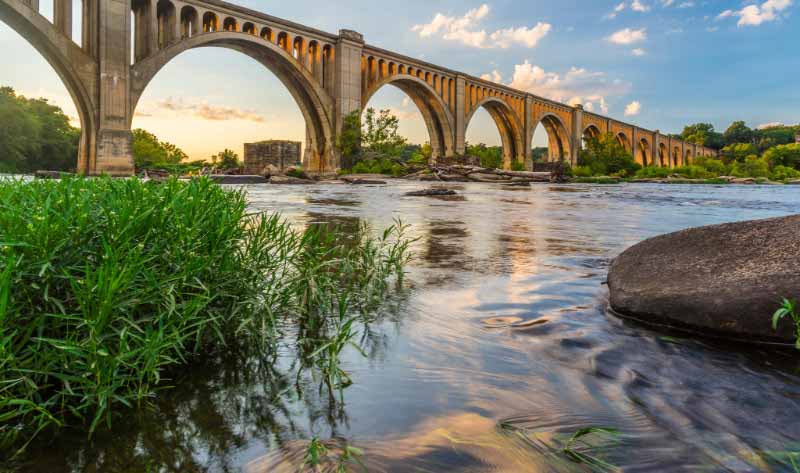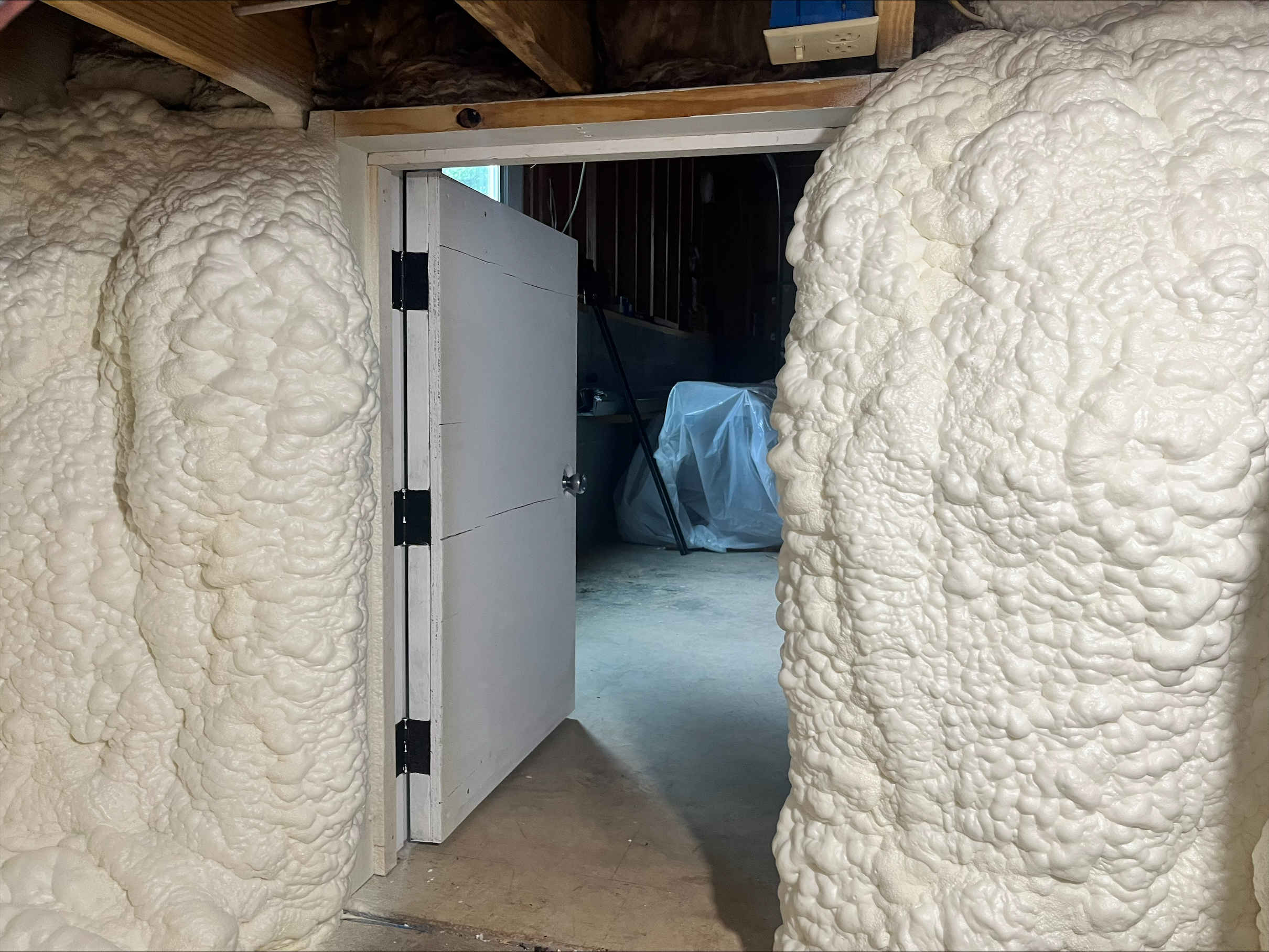The term 1% annual chance flood, also known as a “100-year floodplain,” refers to Special Flood Hazard Areas (SFHA) marked on FEMA flood maps. Specifically labeled as a Zone AE flood zone, these are areas of land with a 1% chance of being covered by a flood in any given year.
Living in an AE flood zone isn’t just a mark on the map. Over the life of a 30-year mortgage, your home has about a 26% chance of flooding, making it a high-risk area. Mortgage lenders typically require flood insurance, and local building codes step in with special requirements to reduce flood damage in these areas.
In Lynchburg, Virginia, knowing your property’s flood zone is vital for both safety and to stay compliant. Let’s learn more about AE flood zones and why homes with crawlspaces in these areas need special care.
What Is a Zone AE Flood Zone?
In Lynchburg, properties along the James River, Blackwater Creek, and other low-lying stream valleys may be in Zone AE and designated an SFHA.

Local city code section 35.2-59 exists as part of the Lynchburg’s Zoning Ordinance to address the properties located partially or entirely within an SFHA and what they can be used for.
Why does this matter? Homes in Zone AE face a much higher flood risk and local floodplain management rules aim to minimize possible flood damage. Lynchburg city officials recently proposed an updated flood ordinance, in line with FEMA’s National Flood Insurance Program (NFIP), that would require any new construction or major renovations in this zone to be elevated 18 inches above base flood elevation (BFE).
This extra height above the BSE is called freeboard and would be an increase from the current requirement of 12 inches. This added margin would boost protection from flood damage for structures in Zone AE and could even lead to lower flood insurance premiums.
How to Check If Your Home is in an AE Flood Zone (Lynchburg and Virginia)
Lynchburg’s online GIS Flood Mapping Tool lets you enter your address and see if any part of your property lies within a special flood hazard area. It provides up-to-date floodplain data for all properties within Lynchburg’s city limits.
For properties outside city limits, use the Virginia Flood Risk Information System (VFRIS) offered through the Virginia Department of Conservation and Recreation. It shows flood zones, base flood elevation, and historical flood data.
These tools supply localized, user-friendly maps specific to your area to help you make informed decisions about insurance and mitigation measures.
Why 1%-Chance Flood Areas Need Special Crawlspace Care
Crawlspaces are common in Virginia but can be a major risk in AE zones if not properly constructed or maintained.
High Risk of Floodwater Entry
Homes in AE zones will flood during a base flood. And even lesser floods can still send water into your crawlspace. Unlike homes on a slab or elevated piers, crawlspaces are low to the ground, where floodwaters can pool and cause structural damage and mold, while also ruining insulation and important systems.
Hydrostatic Pressure on Walls
Floodwater around a foundation creates pressure that can collapse walls if not equalized. That’s why Lynchburg requires flood vents or grates in any enclosed space that lies below flood protection level (that means below the base flood elevation plus freeboard). These openings allow water to flow in and out freely, automatically equalizing hydrostatic forces and reducing pressure. This may seem counterintuitive, but letting water in your crawlspace helps save your foundation from structural damage and failure.

Flood-Resistant Materials Requirement
Building materials below expected flood level must handle getting wet. Standard drywall insulation, and untreated wood are easily destroyed by floods. Instead use flood-resistant materials like concrete, masonry, and pressure-treated/marine-grade lumber that won’t deteriorate if they are briefly in water.
For example, fiberglass batt insulation in a vented crawlspace is not recommended for an AE flood zone since it compresses and grows mold when it gets soaked. Instead, use closed-cell spray foam or rigid foam in your crawlspace to help prevent permanent damage by floodwaters.
No Critical Utilities or Living Space Below BFE
Crawlspaces below BFE should never be finished or used to store valuables. They should only be used for parking, building access, and limited storage of maintenance items. Mechanical or electrical equipment, like HVAC units, ductwork, and water heaters, should be above base flood elevation or protected if they’re not. Some homeowners move them to the attic or install them on elevated platforms to avoid costly repairs.
The Impact of Freeboard on Crawlspace Design and Insulation
The proposed change to raise the freeboard from 12 to 18 inches in Lynchburg’s flood zone ordinance would mean homes in AE flood zones must sit higher. This small change could make a big difference in moderate flood events.
This higher elevation means a safer crawlspace by keeping your floor system further above ground moisture and flood level. That extra six inches of space below your home also means more vertical space could potentially flood during a worst-case event. This means it’s very important to make sure everything within your crawlspace complies with flood-resistant standards. Ensure your pipes, ductwork, and wiring are either kept above the flood level or are sealed and protected from possible submersion.
Choice of Insulation Strategy

When it comes to protecting your crawlspace, the proposed freeboard increase can influence your decision of whether to encapsulate (seal) your crawlspace or keep it vented. In a traditional vented crawlspace, the subfloor is typically insulated with fiberglass or spray foam between the joists. In a sealed, or unvented, crawlspace the foundation walls are insulated instead. Having a sealed crawlspace in a flood zone is not recommended but can be possible with the right flood vents and drainage design. Regardless of which strategy you choose, remember to use flood-compatible insulation such as closed cell spray foam or rigid foam board insulation. And cover the ground with a well-secured, heavy-duty moisture barrier.
Building above BFE + 12” (possibly soon 18”), using flood-resistant materials, and providing flood vents in your crawlspace will help protect your home and ensure you are following all federal and local regulations. Check out Energy.gov’s “Flood-Resistant Crawlspace Foundations” for more details.
Planning and Protecting Your Crawlspace in a Flood Zone
Here’s how to proactively prepare your crawlspace if you live in Zone AE:
Consult Lynchburg’s Floodplain Management
Talk with the city’s floodplain administrator or zoning office before doing foundation or crawlspace work. If you are doing substantial improvements (over 50% of the building’s value) in an AE zone, you’ll need to bring the whole structure to current code. The city will confirm your site’s exact BFE for correct elevation.
Use GIS Flood Map and VFRIS
Make use of the city’s GIS flood map and VFRIS to understand your property’s flood context. These maps show how deep floodwaters may get and will help guide your design decisions, such as installing a sump pump or elevating your water heater well above ground.
Incorporate Flood-Resistant Construction
Hire a contractor that is experienced in floodplain construction. Use materials and methods matched to your crawlspace needs. Make sure any walls, posts or insulation that will be below regulatory flood protection elevation is resistant to flood damage. Ensure proper flood venting is installed. The general rule is a one square inch opening per one square foot enclosed area, on at least two sides. This lets water flow freely during a flood, drain afterward, and reduce moisture entrapment.
Protect Utilities and Insulation
Elevate your mechanical and electrical systems above the flood line. Run your ductwork above flood level or use water-rated ductwork that’s internally insulated with a closed-cell material. When it comes to insulation, remember that closed-cell spray foam and rigid foam board are the best choices. Consider a drainage system such as a sump pump or French drain for seepage prone crawlspaces.
Maintain Flood Vents and Drainage
Regularly check your flood vents and make sure they’re not blocked. After a flood, remove debris, dry out the space quickly, and replace any waterdamaged materials like fiberglass insulation. Ensure the ground around your foundation is graded properly for drainage when floodwaters recede. Quick cleanup will help prevent long-term moisture damage.
Staying Safe and Compliant
Living in an AE flood zone in Lynchburg doesn’t have to feel overwhelming. Respect the risk and take smart precautions, especially for your crawlspace so when the next big flood comes, your home will stand stronger.

Sticking to local regulations, like the Flood Hazard Ordinance’s elevation and construction requirements will help keep you and your family safer and preserve your property’s long-term value. Be sure to reach out to the city’s community development or water resources department for guidance on permits and floodproofing.
Remember the core philosophy of build smart, build higher, and let water have its way (and way out) when it comes. A welldesigned crawlspace in Zone AE lets floodwaters enter harmlessly, uses materials that can handle wetness, and keeps your living space and systems safely above flood levels. The proposed 18inch freeboard, when approved and enforced, will provide an even greater buffer for your home.
Ultimately, by staying informed and proactive and using available tools and codes, you protect your home, your belongings, and your peace of mind when waters rise.
Toler: Your Local Expert in Crawl Space Preparation
Toler Insulating has been an active part of our Lynchburg community since 1994. We’re experts in crawl space insulation and are here to help with all your crawl space needs. You can count on us for expert solutions and quality work every time. Contact us today for your free estimate.
References
FEMA Emergency Management Institute Learning Management System. (n.d.). IS-273: Managing floodplain development through the National Flood Insurance Program. Retrieved from https://emilms.fema.gov/is_0273/groups/157.html#:~:text=Flood%20Insurance%20Program%20,year%20mortgage
JLC Online. (n.d.). Soundings: Sealed crawlspaces in flood zones. Retrieved from https://www.jlconline.com/how-to/soundings-sealed-crawlspaces-in-flood-zones_o#:~:text=To%20relieve%20hydrostatic%20pressure%20on,might%20cave%20in%20the%20foundation
JLC Online. (n.d.). Soundings: Sealed crawlspaces in flood zones. Retrieved from https://www.jlconline.com/how-to/soundings-sealed-crawlspaces-in-flood-zones_o#:~:text=To%20build%20a%20sealed%20crawlspace%2C,and%20providing%20plenty%20of%20drainage
City of Lynchburg, Virginia. (n.d.). DocumentCenter: Floodplain ordinance PC report and floodplain management ordinance. Retrieved from https://www.lynchburgva.gov/DocumentCenter/View/4905/Floodplain-Ordinance-PC-Report-and-Floodplain-Management-Ordinance#:~:text=,annual%20chance
City of Lynchburg, Virginia. (n.d.). Know your flood risk. Retrieved from https://www.lynchburgva.gov/321/Know-Your-Flood-Risk#:~:text=%2A%20Section%2035.2,purposes%20of%20these%20amendments%20are%C2%A0to
City of Lynchburg, Virginia. (n.d.). Know your flood risk. Retrieved from https://www.lynchburgva.gov/321/Know-Your-Flood-Risk#:~:text=,above%20the%20Base%20Flood%20Elevation
City of Lynchburg, Virginia. (n.d.). Know your flood risk. Retrieved from https://www.lynchburgva.gov/321/Know-Your-Flood-Risk#:~:text=Flood%20Hazard%20Area%20,of%20the%20structure%20or%20floodproofing
City of Lynchburg, Virginia. (n.d.). Know your flood risk. Retrieved from https://www.lynchburgva.gov/321/Know-Your-Flood-Risk#:~:text=Which%20Properties%20are%20Affected%3F
City of Lynchburg, Virginia. (n.d.). Know your flood risk. Retrieved from https://www.lynchburgva.gov/321/Know-Your-Flood-Risk#:~:text=floodplain%20is%20to%20check%20the,SFHA
City of Lynchburg, Virginia. (n.d.). Know your flood risk. Retrieved from https://www.lynchburgva.gov/321/Know-Your-Flood-Risk#:~:text=Flood%20maps%20and%20flood%20protection,panels%2C%20LOMC%20information%2C%20and%20more
City of Lynchburg, Virginia. (n.d.). DocumentCenter: Floodplain ordinance PC report and floodplain management ordinance. Retrieved from https://www.lynchburgva.gov/DocumentCenter/View/4905/Floodplain-Ordinance-PC-Report-and-Floodplain-Management-Ordinance#:~:text=,the%20following%20minimum%20design%20criteria
City of Lynchburg, Virginia. (n.d.). DocumentCenter: Floodplain ordinance PC report and floodplain management ordinance. Retrieved from https://www.lynchburgva.gov/DocumentCenter/View/4905/Floodplain-Ordinance-PC-Report-and-Floodplain-Management-Ordinance#:~:text=protection%20elevation%20shall%3A%20,stairway%20or%20elevator